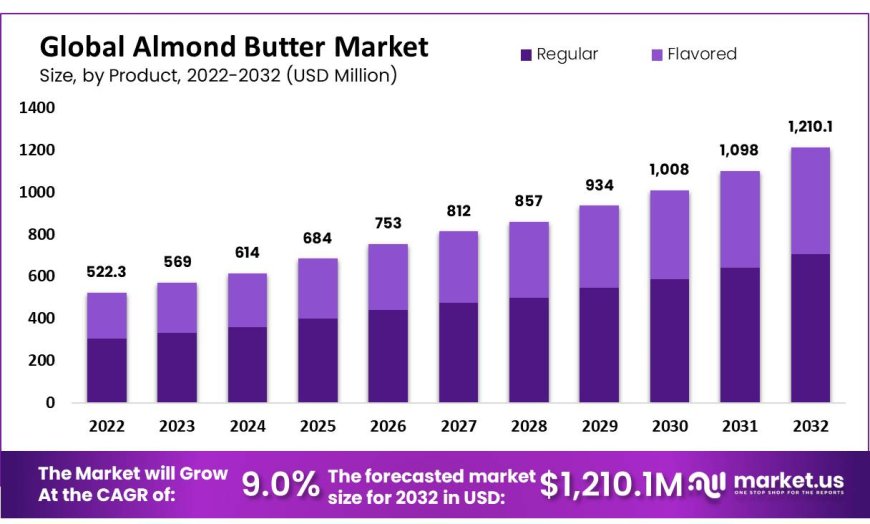Analysis Of Almond Butter Market Drivers, Restraints&Challenges, Opportunities and Supply Chain.

Market Overview
The almond butter market was worth $522.3 million in 2022 and is expected to be worth $1210 million by 2032. The market is expected to grow at a CAGR of 9.0% from 2023 to 2032.
The almond butter market has experienced significant growth in recent years. Almond butter is a popular alternative to traditional peanut butter, as it offers a rich and creamy texture with a slightly sweet and nutty flavor. It is made from ground almonds and is known for its nutritional benefits, including being a good source of healthy fats, protein, and fiber.
Top Key Players
· Unilever
· Procter & Gamble
· The J.M. Smucker
· Hormel Foods Corporation
· Boulder Brands
· The Kraft Heinz
· Algood Food Co.
· Conagra Brands, Inc
· Britannia Dairy Private Limited
· Hormel Foods Corporation
· Justin’s, LLC
· The Leavitt Corporation
· DiSano
· Alpino
· Pintola
· Other Key Players
Get a free Sample Copy of This Report@ https://market.us/report/almond-butter-market/request-sample/
Key Market Segments
Based on Product
· Regular
· Flavored
Based on Nature
· Organic
· Conventional
Based on Distribution Channel
· B2B
· HoReCa
· Food & Beverage Processing Industry
· Personal Care & Cosmetic Industry
· B2C
· Hypermarkets & Supermarkets
· Online
· Others
Almond Butter Market Drivers:
- Increasing consumer demand for healthier food options: As consumers become more health-conscious, they are seeking alternatives to traditional spreads like peanut butter. Almond butter, with its nutritional benefits and healthier profile, is gaining popularity.
- Growing popularity of plant-based diets: The rise in plant-based diets, driven by environmental concerns and health benefits, has contributed to the increased demand for almond butter as a plant-based alternative to animal-based spreads.
- Awareness of almond health benefits: Almonds are known for their nutritional value, including being a good source of healthy fats, protein, and fiber. The awareness of these health benefits has driven the demand for almond butter.
Restraints and Challenges:
- Rising cost of almonds: The cost of almonds has been increasing due to various factors, including supply and demand dynamics and climate change. This can impact the pricing of almond butter products and potentially limit market growth.
- Competition from other nut and seed butter: Almond butter faces competition from other nut and seed butter, such as cashew butter and sunflower seed butter. The availability of alternative options may affect the market share of almond butter.
· Shelf life and storage requirements: Almond butter has a relatively shorter shelf life compared to some other spreads, and proper storage conditions are required to maintain its quality. This can pose challenges for manufacturers and retailers in terms of inventory management and product freshness.
Opportunities:
- Product innovation and diversification: There is an opportunity for manufacturers to introduce new flavors, organic options, and single-ingredient almond butter products to cater to different consumer preferences and expand their customer base.
- Growing online retail channels: The rise of e-commerce and online grocery platforms provides an opportunity for almond butter brands to reach a wider audience and increase their market presence.
Supply chain analysis:
- Almond Cultivation: The supply chain begins with almond farmers who cultivate almond trees. Almonds are typically grown in regions with suitable climate conditions, such as California in the United States, which is one of the largest almond-producing regions globally.
- Harvesting and Processing: Once the almonds are mature, they are harvested and processed. This involves removing the outer hull and drying the almonds to reduce moisture content. The processed almonds are then sorted and graded based on size, quality, and other factors.
- Almond Butter Manufacturing: The graded almonds are sent to almond butter manufacturers. The almonds are roasted to enhance flavor and then ground into a paste. Additional ingredients, such as salt or sweeteners, may be added depending on the desired product variation.
- Packaging and Labeling: The almond butter is packaged into jars, tubs, or other suitable containers. Labels are applied, providing information about the product, including ingredients, nutritional facts, and branding.
- Distribution and Logistics: The packaged almond butter is then transported to distribution centers or warehouses. From there, it is distributed to retailers, including supermarkets, health food stores, and online platforms. Logistics companies play a crucial role in ensuring efficient transportation and timely delivery of products.
- Retail Sales: The almond butter is made available to consumers through various retail channels. Consumers can purchase almond butter from physical stores or online platforms, depending on their preferences.
- Consumer Consumption: Finally, consumers purchase and consume almond butter for various purposes, such as spreading it on bread, using it as an ingredient in recipes, or adding it to smoothies.
Contact us:
Global Business Development Team: Market.us
Market.us (Powered By Prudour Pvt. Ltd.)
Send Email: inquiry@market.us
Address: 420 Lexington Avenue, Suite 300 New York City, NY 10170, United States
Tel: +1 718 618 4351, +91 78878 22626
What's Your Reaction?
 Like
0
Like
0
 Dislike
0
Dislike
0
 Love
0
Love
0
 Funny
0
Funny
0
 Angry
0
Angry
0
 Sad
0
Sad
0
 Wow
0
Wow
0













































